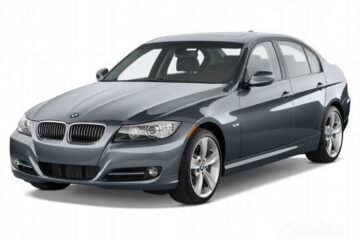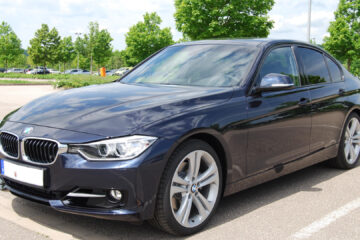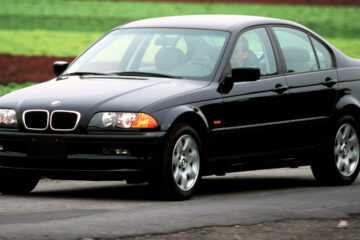The BMW 3 Series E21 is actually the first official third-series model from the Bavarians. There are certain similarities in this car with the 2002 model, which was replaced by the E21 compact car in 1983. The development of this car began back in 1970, when the company decided to remove the outdated 2002 model from production by designing a more modern car with improved performance. The debut of the BMW E21 coupe took place in 1975 at the Olympic Stadium, which is located in Munich. The public met the novelty from the Bavarians quite warmly, and everyone liked it at once. The car was not distinguished by a special design. Everything was made in a classic for BMW manner. Headlights were round, the hood was made wedge-shaped and it slightly protruded beyond the limits of the car, the car was not left without branded “nostrils” for air intake. Small wheelbase in combination with compact dimensions of the body allowed the model to get sporty proportions, which fully corresponded to the ideology of the concern.
The BMW 3 Series E21 was equipped with rack and pinion steering and the classic familiar McPherson front suspension. The rear part of the car provided a lever design. In the first modifications, a four-speed manual gearbox, common at the time, was installed. In 1980, a five-range transmission was added. In addition to these boxes, it was possible to meet the car with a gearbox with 3 speeds. The car was equipped with a combined braking system. The front wheels were stopped with a disc design, and the rear part was braked by drums. The middle of the 70’s was marked by a large investment in BMW E21 engines, which were labeled M60, but were eventually renamed M20.
Model history
BMW 3 Series Coupe is the direct successor of the Neue Klasse model from the Bavarians, which was produced from 1962 to 1975. This model was produced in various body designs, starting from a sedan with 4 doors, and ending with a sports coupe with three doors. In 1975, after a huge number of modifications, the company’s management decided to update the car and move to a new classification of the model range. This led to the fact that in July 1975, the E21 was presented to public attention. This car marked the beginning of a new class of Bavarian cars – the 3rd series. The body layout of the car was classic for that time – a coupe with three doors of medium size.
But the popularity of the new car was observed not only among fans of cars of the German manufacturer, but also among race fans. The Motorsport department of BMW developed a unique power unit, designed to be installed on the racing modification. Its maximum power was about 300 horsepower. The car began to participate in races, being in the McLaren team. Over time, the BMW E21 alpina b6 replaced the old model in the team of racers of the German automobile company BMW.
In addition to the fact that the standard version was produced in coupe bodywork with two doors, the lineup also included a cabriolet. But this car was produced in a limited edition and was not very popular among fans of Bavarians. 1983 was marked by the completion of production of the first model of the third generation. While the car was on the conveyor belt, it received 8 modifications of the power unit.
Appearance
In the photo, it is noticeable that the appearance of the car in the front part is dominated by the trademark grille across the body. Later, this decision became a cult and classic style for all cars of the German manufacturer. The E21 style was somewhat similar to the E12 modification of the fifth series.
The first thing that catches your eye when you look at the photo of the BMW E21 or at the car in person is the wedge on the hood. It gradually rises to the very beginning of the windshield. A black plastic overlay was added between the taillights, which added aggressiveness to the appearance of the model. The pillar was C-shaped with the then classic Hofmeister bend, which was used on almost all BMW cars of those years.
In the 80’s there was no tradition of coating body elements with zinc. At that time, a common etching primer with a high phosphorus content was used. This allowed to achieve that the car body was not covered with small scratches during operation. But the cars are already quite a few years old, so it is very difficult to find on the modern secondary market E21 with a body in normal condition and without rust.
The dimensions of the BMW E21, as already mentioned, are relatively small: the length of the body is only 4359 millimeters, with a width of 1610 millimeters, while the height of the car is 1379 millimeters. The ground clearance is 145 millimeters, and the wheelbase was allocated 2560 millimeters. The weight of the car in a curb weight of 1010-1135 kilograms, depending on the modification. Size of disks BMW E21 165 SR13.
Interior
It is pointless to talk about the interior and various technical components inside the car, as at that time there was practically nothing there. Until 1980, all models of the third series were equipped with one version of the interior. After 1981, they began to install different interior details in the versions, depending on their engines.
The 1981 model, equipped with a six-cylinder engine, featured the highest quality upholstery materials. All models had a tachometer inside, a familiar feature of the BMW 320 series.
Motors
The BMW 315 e21 was powered by the M10 powertrain, which was previously labeled M98. It provided 1.6 liters of working volume, which allowed it to develop power up to 75 horsepower. At the same time, the average fuel consumption was about 8.8 liters per hundred kilometers. The maximum speed of the modification was 160 kilometers per hour, and the first hundred it gained in 14.8 seconds.
Under the hood of the BMW 316 E21 there was a 1.6 liter M10 (M41/M116) engine, which was able to provide a maximum power of 90 horsepower. Since 1980, engines for 2 liters of working volume M99 began to be installed. The average fuel consumption was 9.5 and 9 liters respectively. The maximum speed of such a car was 160 and 163 kilometers. The first hundredth E21 with such motors and gained in 13.8 and 12.5 seconds.
On the modification 318 was installed power units M10, which were also called M42 and M118. These motors were distinguished by a working volume of 1.8 liters, which gave them the ability to provide 72 horsepower of maximum power. The 318th E21 consumed about 9.6 liters of fuel, and could reach the first hundred in 11.9 seconds, and its top speed was 168 kilometers per hour.
On the 318i modification, the Bosch K-Jetronic system was used, as indicated by the index i in the model marking. This was done in order to replace the old Solex carburetor. On such cars was installed motor M10 (M92) with a working volume of 1.8 liters, which allowed to provide BMW E21 technical characteristics in the form of 105 horsepower of maximum power. At the same time, its top speed was 175 kilometers per hour, and it consumed an average of about 8.9 liters. The modified fuel injection system allowed to provide acceleration to a hundred in 11.5 seconds.
The BMW 320 E21 version had a four-cylinder version of the M10 engine (also M43 and M05). The working volume of the power unit was 2 liters. At the same time, its peak performance reached 109 horsepower. The characteristics of the BMW E21 with this engine allowed it to reach the first hundred in 11.2 seconds, while it consumed 10 liters of fuel and accelerated to 173 kilometers per hour.
There was also a six-cylinder version of the 320 with mechanical fuel injection. It was equipped with a power unit M20 (M60), which had the same volume of 2 liters, but differed by 122 horsepower of maximum power. Fuel consumption by such a motor decreased to 9.9 liters, and the top speed increased to 183 km/hour. The car reached the first hundred meters in 10.7 seconds.
The 320i modification provided for the installation of injector and was equipped with M10 engines with 2 liters of working volume. They developed maximum power up to 125 horsepower. Fuel consumption per hundred kilometers of mileage was 9.4 liters. The maximum speed of such a car was 182 kilometers per hour, and the first hundredth he gained in 9.9 seconds.
BMW 323i E21 was the last modification in this body. It was equipped with M20 (M60) motors, which had the largest volume of 2.3 liters and provided 143 horsepower. Such a power unit was able to accelerate the car to 190 kilometers, and the first hundred 323-aya gained in 9.5 seconds. Consumption per hundred kilometers was about 9.6 liters.
It is also possible to find on the secondary market tuning version of the car, which was installed engine six with a carburetor for 150 horses of maximum power in 1980. But such cars are very rare.
Restyling
The end of 1979 brought certain changes to the E21. Underhood space was slightly redesigned, which made it possible to place a power unit-driven fan on modifications with six-cylinder engines. But because of this, the cooling radiator mounting on four-cylinder models had to be slightly redesigned to avoid moving the radiator.
The interior space has also undergone some changes. The most notable modernization was the change of the ventilation and heating control panel. This year was also marked by the complete discontinuation of the M10 4-cylinder engine, equipped with an injector. It was produced since 1977 for cars exported to America. It was replaced by a new version of the M10 with 1.8 liter displacement, equipped with a new K-Jetronic Lambda injector, working in conjunction with a catalytic converter.
In the middle of 1983, production of the BMW E21 third-series was stopped as the next generation 3-series was introduced.
Generations and configurations
Coupe 1st generation
08.1975 – 12.1982
| 315 MT | M10 (M98) | 1.6L | 75 hp |
| 316 MT | M10 (M41) | 1.6L | 90 hp |
| 316 MT | M10 (M118) | 1.8L | 90 hp |
| 318 MT | M10 (M118) | 1.8L | 98 hp |
| 318i MT | M10B18 | 1.8L | 105 hp |
| 320/4 MT | M10 (M43) | 2.0L | 109 hp |
| 320/6 MT | M20B20 | 2.0L | 122 hp |
| 320i MT | M10 (M64) | 2.0L | 125 hp |
| 323i MT | M20B23 | 2.3L | 143 hp |



0 Comments